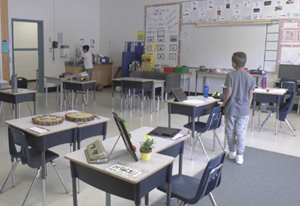Saturday May 16, 2020 ~ BC
by Mary Brooke ~ West Shore Voice News
Students in BC have been in ‘pandemic mode’ since spring break in mid-March. They heard March 17 that they would not be returning to in-class instruction after spring break. When March 30 came, students effectively had another week off school while teachers took about 10 days to prepare an entirely new way to deliver curriculum by remote means.
That process has now been humming along but taking its toll on families, teachers, and students in various ways, not to mention running administration off their feet keeping the many areas of activity (curriculum delivery, staff needs, running a few schools for the children of essential workers, and beefing up their IT deliverables).
Now comes the opportunity to get back toward ‘normal’.
Inching back to a ‘new normal’ in K-12 schools:
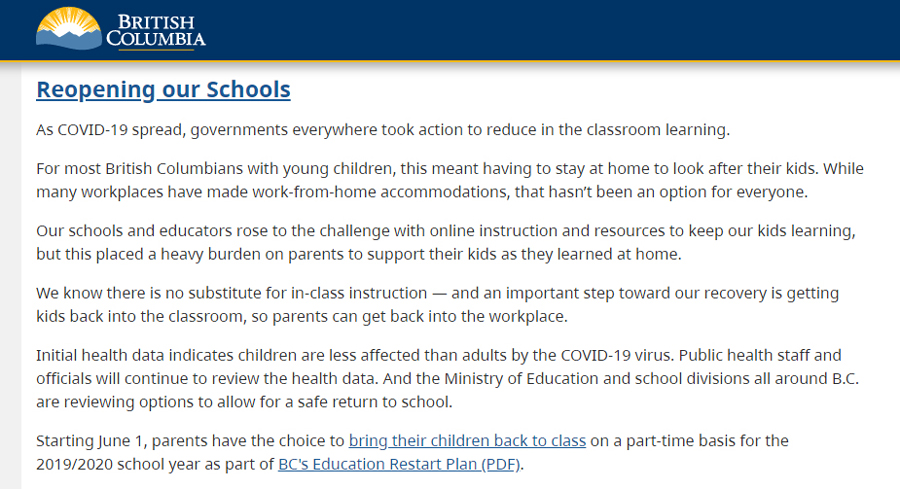
Then yesterday, May 15, Minister of Education Rob Fleming — backed by Premier John Horgan and Provincial Health Officer Dr Bonnie Henry — announced that students in BC could start heading back to class at their schools starting Monday June 1.
Like starting up a car that’s been sitting idle for a while, there will likely be a few bumpy moments. Afterall, no one anywhere has had to deal with restarting a school system after a pandemic, it’s new territory for everyone.
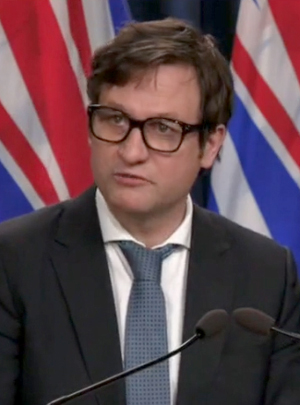
Everyone has seemed patient enough during the last two months of ‘school at home’ — including parents, students, teachers and school staff — but getting back to something resembling normal life is probably welcome all the way around.
Even though it’s only for June, getting the schools up and running again will wrap up the 2019-2020 academic year with some sense of demarcation.
Test-run in June, for broader return in September:
The one-month back-to-school scenario in June will also give administration, janitorial staff and teachers a test-run on the physicality of operating schools in accordance with physical distancing.
Students and teachers are to remain two metres or six feet apart, or wear masks if unavoidably closer than that for a period of time. Frequent hand washing will be necessary; stations and schedules must be set up for that.
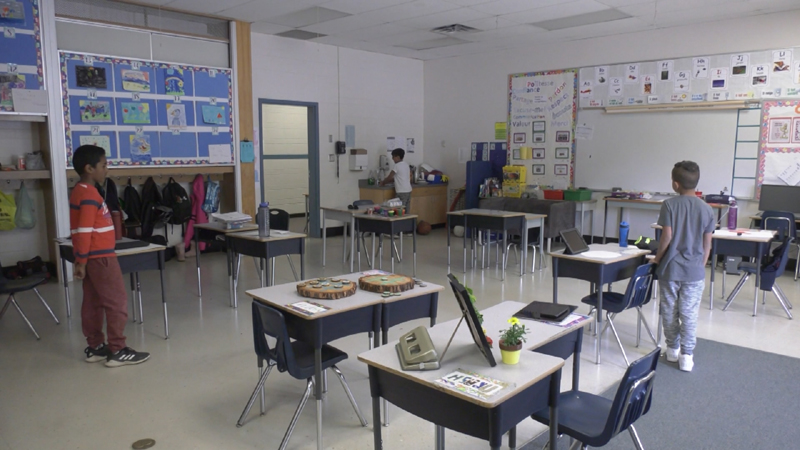
Whatever is learned in June about the classroom setup, curriculum scheduling, what works and what doesn’t with transportation and staggered times for arrival, recess, lunch and pickup can be reviewed and revised over the summer.
Parents have big decisions to make:
Parents and guardians have a big decision to make ahead of June 1, as to whether or not they wish to start sending their children back to school. Many children probably want to see their friends again, and parents could probably use a break from overseeing learning at home.
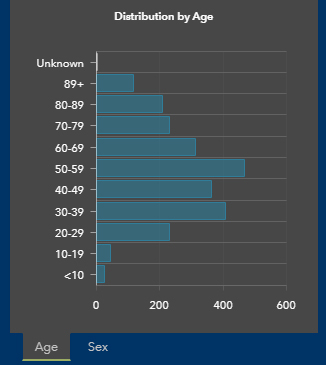
But there is a real safety consideration to think about. We are, afterall, still in a pandemic; today 15 new COVID-19 test-positive cases were reported.
Today Dr Henry said that there have been 69 cases of COVID-19 among children in BC so far (24 cases in kids under age 10, and 45 cases in the 10 to 19 age group), though only three hospitalizations among children, and no deaths due to COVID-19 among children.
Although today Dr Henry did acknowledge that a cardiovascular condition is seen in some children who have had the COVID-19 infection. Called Multisystem Inflammatory Syndrome in Children (MISC), the condition seemed to affect children more than adults.
Because children and teens are often asymptomatic if they do get a COVID-19 infection, they are more likely to be the source of infection for adults — rather than adults impacting children with exposure to the disease (because if adults have it, they will be self-isolating).

Other than the natural vulnerability of seniors (due to a generally more battered immune system simply by virtue of age), it could be argued that the distribution of infection by age aligns somewhat with distribution of exposure. Adults out working in essential roles during the pandemic will have had more exposure than children who stayed home.
Most people have by now learned the protective measures against becoming infected by COVID 19: frequent hand washing, not touching one’s nose, mouth or eyes, physical distancing (two meters or six feet apart), wearing a mask, and staying home if feeling the least bit unwell. But it’s easy to see how any portion of that could be less than perfectly applied in a school-day setting.
It’s a tough call for parents. Protect at home but in social isolation, or reconnecting with the larger group but taking a health risk.
A different flavour of June for Grade 12s:
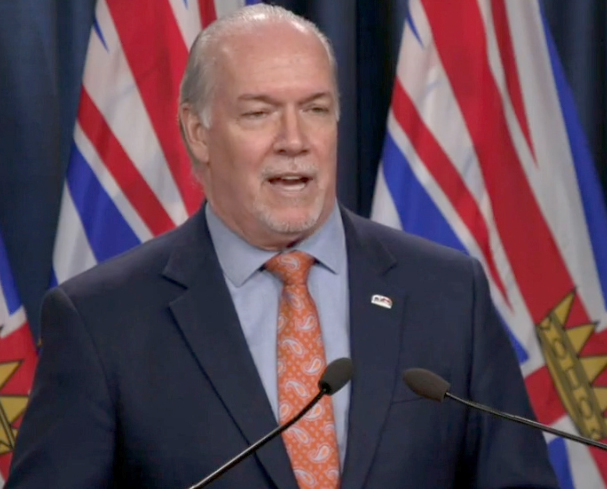
Grade 12 graduating classes seem to have been dealt with relatively effectively, and most students seem to have been able to proceed with applications for post-secondary school and scholarships.
As for grad ceremonies, that has been some matter of debate. School districts have been left to figure out how to deliver on that traditional activity while adhering to physical distancing protocols. However, on Friday there was a bit of a green light from the Premier and the Provincial Health Officer for some sort of altered but real-time grad ceremony activity.
We’re almost at Phase 2 (May 19 to 31, 2020):
We’ve been in Phase 1 of the COVID-19 pandemic during the last two months in BC, with only essential services operating and people otherwise advised to self-isolate at home (and do physical distancing if making essential trips for groceries or other situations). Phase 1 of Restart BC has included schools providing in-class learning for the children of essential workers.
Phase 2 runs May 19 to 31. In the education system, BC’s 60 school districts and teachers within them are now preparing for a non-mandatory part-time return to classrooms that will start June 1 in Phase 3.
Over the next two weeks, people throughout communities will be getting back out into more regularly activity and taking part in the reopening of some of the economic sectors that were ordered closed (or effectively made to close due to physical distancing requirements) during the pandemic. That is being guided by the Restart BC framework as launched by Premier Horgan on May 6 (and updated with more business sector protocols on May 15).
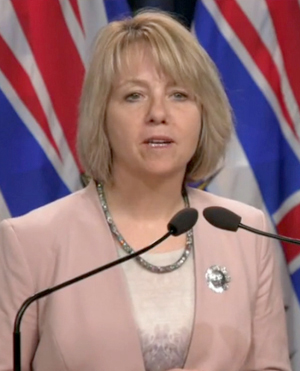
Provincial parks were re-opened a few days ago on May 14 (for day use only) as a prelude to Phase 2. That has given a bit of wiggle room for families who are itching for a day-outing on this May long weekend.
But otherwise people have been strongly reminded not to travel beyond their local neighbourhood or area this weekend, so as not to strain health care and community resources (recognizing the ever-recurring 14-day incubation period at each stage of re-opening, though Dr Henry says incubation could be complete within five to seven days).
The full Phase 2 of Restart BC — which for most people will seem like the first real steps toward the new normal — starts Tuesday May 19 after the May long weekend, and will run through the rest of this month. The retail sector, personal service establishments, dental offices, restaurants, offices, sports, and other sectors will be allowed to operate in accordance with detailed protocols.
Phase 3 includes K-12 trial run in June:
Phase 3 of Restart BC is set for June to September based on COVID-19 transmission rates remaining low or being in decline.
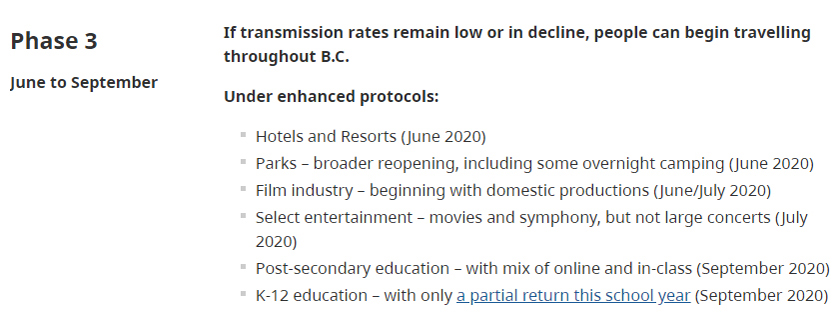
That includes a voluntary and restricted return of students to classrooms. Children in Grades K to 5 will attend about two to three days per week, and youth in Grades 6 to 12 may attend up to 20% of the school week (approximately one day) with the rest of learning being done remotely and online. There will be staggered arrival/departure, recess/lunch, and regular hand washing.
Phase 3 for all of K-12 includes launching an active academic year in September 2020 being called “a partial return to school”, according to the Restart BC documentation. See “Restarting BC Schools” (as last updated May 15, 2020).
The economy in Phase 3:
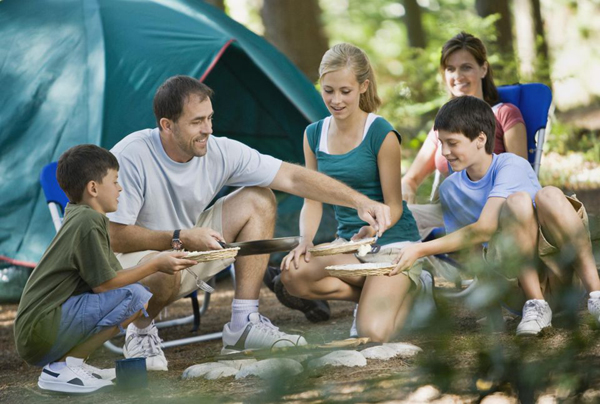
Phase 3 (June through September) will see more activity in communities and the economy, which could allow opportunities for enhanced community spread of COVID-19, mixed in with the seasonal return of influenza and other respiratory illnesses.
With enhanced protocols, Phase 3 will also include increased operation of hotels and resorts and some broader park operations including some overnight camping (June), film industry domestic productions can get rolling (June/July), movies and symphony but not large concerts can happen (starting July), and post-secondary can get rolling with a mix of online and in-class attendance (September).
Resources to assist businesses and sectors as they restart their activities including new Health Guidelines and Checklists are available from WorkSafeBC.
Phase 4 has no exact start date:
Phase 4 for coming out of pandemic mode in BC is conditional on at least one of the following: wide vaccination, “community” immunity, broad successful treatments.
There will be a return to activities that require large gatherings, such as conventions, live-audience professional sports, concerts, and international tourism.
The timing of a safe restart of nightclubs, casinos and bars is a more complicated consideration, as stated in the Restart BC documentation. As with other sectors, industry associations will be expected to develop safe operations plans, for review, that are in keeping with Public Health and Safety Guidelines, as well as WorkSafeBC.
Resources to assist businesses and sectors as they restart their activities including new Health Guidelines and Checklists are available from WorkSafeBC.


